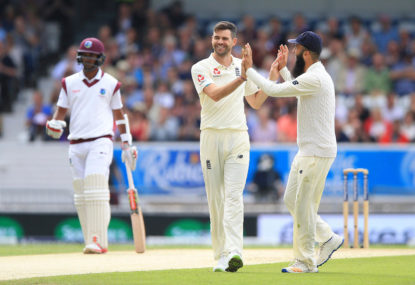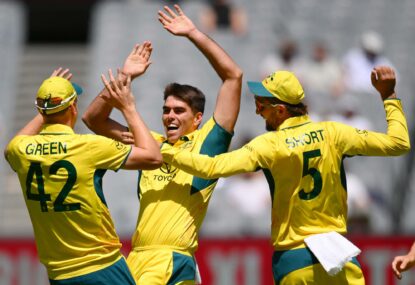England’s evergreen fast bowler James Anderson needs only seven more Test wickets to overtake Australian Glenn McGrath as the most successful fast bowler of all-time.
McGrath’s 563 scalps came from 124 Tests between 1993 and 2007 off 29,248 deliveries at an average of 21.64.
His success was built around his metronomic line and length, working on the premise of ‘you miss, I hit’ – producing an economy rate of 2.47.
Anderson’s career began in 2003, and with two Tests in hand against India at home has 557 wickets off 31,065 deliveries, at an average of 26.85.
The 36-year-old is far more productive on English wickets, claiming 361 of his 557 wickets at an average of 23.72.
But he’s averaging 40.72 in Sri Lanka, 39.92 in South Africa, 35.43 in Australia, and 33.46 in India.
Nonetheless, for the last 15 years Anderson has been England’s spearhead.

England’s James Anderson. (AP Photo/Kirsty Wigglesworth)
For most of the time, his new-ball partner Stuart Broad has also had a stellar career with 427 wickets at 28.91, giving the duo 983 career wickets between them – the benchmark in cricket history – at an average of 27.79.
The closest, West Indians Curtly Ambrose and Courtney Walsh have tallied a combined 924, but averaging a cheap 22.93. More about that magnificent pair shortly.
But the very best fast bowler I’ve even seen is Australian Alan Davidson.
With an easy-striding 15-pace approach, left-armer Davidson was deadly accurate. He was armed with a late dipping in-swinger – and with exactly the same action and delivery, angled across the right-handed batsman, and away from the leftie.
His figures prove the point.
Between 1953 and 1963, Davidson played 44 Tests, bowled 11,587 deliveries, and took 186 wickets at 20.53, with an economy rate of 1.97.
I had the privilege of playing against him for a number of years in Sydney first grade cricket, and can vouch for his impossible-to-pick deliveries.
But he was very nearly lost to cricket as a country boy teenager at Lisarow outside of Newcastle, in NSW.
He was just as brilliant a rugby league fullback as he was a cricketer, and was torn between the two as he looked to the future.
In a zone final, a small kid with dazzling footwork ran around Davidson five times for tries, that settled the decision.
The small kid was Clive Churchill, and both went on to become legends in their sports.
But Davidson had a lot more to his cricketing armour than being a superb left-arm quick.
He went into the famous tied first Test against the West Indies at the Gabba in 1960 with a broken finger, but came out the first all-rounder in history to score 100 runs, and take ten wickets, in the same Test.
What a time to do it.
Davidson cracked 44 and 80 with the bat, and grabbed 5-135 off 30 and 6-87 off 24.6 with the ball.
To complete the Davidson package, he was quickly called ‘the Claw’ with his sensational catches around the corner, at leg slip.
So ‘Davo’ gets my individual salute – but West Indian captain Clive Lloyd, one of the all-time great blokes of international cricket, gets my collective recognition.
At the completion of the 1975-75 series which Australia won 5-1, Lloyd told me in a Channel Seven interview – “Lordy, I make you this promise, from here on in we will blast opponents off the planet”.
True to his word, the Windies went into a brutal era of fast bowling headed by Andy Roberts, Michael Holding, Malcolm Marshall, Joel Garner, Curtly Ambrose, and Courtney Walsh.
There were others en route, but those six were the key bowlers in the Clive Lloyd plan.
Not only were they genuinely quick, but most came from a great height, making eye levels to pick up the length difficult.
[latest_videos_strip category=”cricket” name=”Cricket”]
Garner was 203 cms tall, Ambrose 201, Walsh 198, and Holding 192.
Marshall was by far the shortest at 180, but he was the quickest, and constantly had opposition batsmen defending their bodies, let alone trying to score runs.
The super six took 2010 wickets between them for 42,493 runs, at an average of just 21.14.
It proved after all that Clive Lloyd’s prediction was spot on.






































































































